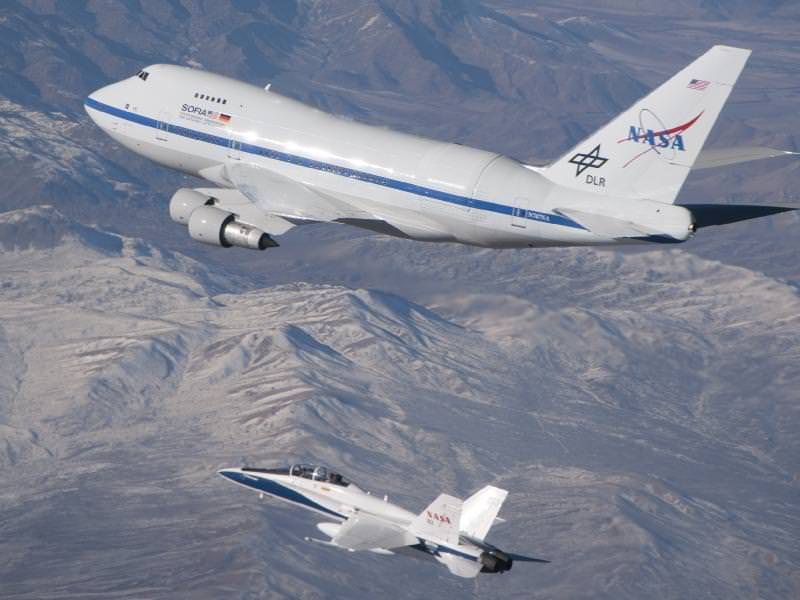If you’ve ever been out observing and the clouds roll in, undoubtedly you’ve thought, “If I could only get above all of these stupid clouds, the sky would look great!” Well, NASA’s Stratospheric Observatory for Infrared Astronomy (SOFIA) is capable of doing just that: SOFIA is an infrared telescope mounted on a 747SP airliner that used to be a passenger plane for Pan Am. By mounting the telescope on an airplane, NASA is able to fly it into the stratosphere, and get past all of the annoying gases and water vapor that get in the way when making observations.
SOFIA is still undergoing a battery of testing to ensure proper operation of the telescope before it starts observations. In December of last year, the telescope was taken up and the doors to the bay where it is mounted were opened. On January 15th, the telescope was flown to 35,000 feet (10.6 km) and the doors were left closed to test an updated gyroscope that was installed on the ‘scope.
These latest tests were designed to test how well the telescope can stabilize itself, because an airplane flying at 41,000 feet (12.5km) – the altitude at which many observations will be made – isn’t exactly a steady mount for a telescope. Gyroscopic stabilizers counteract the movement of the airplane to steady the telescope for observation.
During the test, the ability of the entire system to operate at cooler temperatures was established as well. The temperature for this latest test hovered around -15 degrees Celsius (+5 degrees Fahrenheit) even with the doors closed.
The telescope itself has a 2.5 meter (8.2 foot) mirror, with a 0.4 meter (1.3 foot) secondary mirror. The range of wavelengths that SOFIA can “see” is 0.3 microns to 1.6mm, meaning it’s capable of taking images in the infrared and submillimeter.
Some of the objects and phenomena that SOFIA will be observing include proto-planetary disks and planet formation, star formation, the chemical composition of other galaxies and interstellar cloud physics. An extensive description of SOFIA’s capabilities can be found on their site here.
SOFIA still has a few tests to undergo, and will be fully operational come 2014. In the next few years basic science observations will start up, and then other instruments will be added to the observatory. SOFIA is a collaboration between NASA and a German telescope partner, Deutsches SOFIA Institute.
Source: NASA press release


Excellent idea for cheap, almost interference-free observations.
My first thought upon reading the title was how such a telescope could ever achieve stability, but then I found the answer a couple of paragraphs below.
If gyroscopes could nail these scopes for steady operation, they would be great.
Definitely high hopes for SOFIA, and rightly so. Its predecessor, the Kuiper Airborne Observatory, was responsible for the discovery of the Uranian ring system in 1977. Big news at the time (only Saturn was known to have rings).
This is really cool, although stabilizing the telescope properly sounds pretty challenging!
Ok…I get that most of this is probably about “cost” more than anything else but…isn’t this what devices such as Hubble, Spitzer, etc., are supposed to be for…getting the scope out of Earth’s atmosphere?
Yea…I know that something like Hubble costs hundreds of millions to put up there and that maintenance and upkeep are difficult at best and just as expensive but still…jet fuel and such aren’t exactly cheap either and developing those gyroscopes just so the scope is actually usable and such has got to be costly as well not to mention the cost of upkeep for the aircraft. Over the long run this really doesn’t seem as though it would be -that- much less expensive, at least when based on the cost to benefit ratio. Seriously…what is this thing going to be able to “see” that a device such as Hubble can’t?
This really is just my own personal and somewhat feeble opinion of course but to me it seems this is more of a step backwards compared with what we’ve already achieved. Here’s an ambitious idea…how’s about a lunar based telescope? Now -that- would be sweet…..